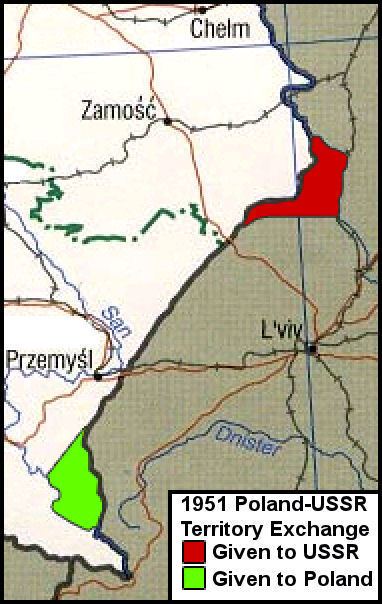 | ||
The 1951 Polish–Soviet territorial exchange or Polish-Soviet border adjustment treaty of 1951 was a border adjustment signed in Moscow between the People's Republic of Poland and the Soviet Union regarding roughly 480 km2 (185 sq mi) of land, along their mutual border. The exchange was made to the decisive economic benefit of the Soviet Union due to rich deposits of coal given up by Poland; these deposits were discovered well before World War II. Within eight years following the agreement, the Soviets built four large coal mines there with the total mining capacity of 15 million tons annually.
In exchange, the Soviet Union ceded part of the Ukrainian SSR's Drohobych Oblast (1939–1959): the city of Ustrzyki Dolne and the villages of Czarna (Ukrainian: Чорна Chorna), Shevchenko (whose name was restored back to prewar Polish name Lutowiska in 1957), Krościenko, Bandrów Narodowy, Bystre and Liskowate. All of this territory became part of the Krosno Voivodeship in 1975, and of the Subcarpathian Voivodeship on 1 January 1999. It was a stretch of barren land with low quality soil and without any natural resources.
Poland gave up part of the Lublin Voivodship, with the cities of Bełz (Ukrainian: Белз Belz), Uhnów (Угнів Uhniv), Krystynopol (Червоноград Chervonohrad) and Waręż (Варяж, Varyazh). All of this territory is now part of the Sokal Raion (Сокальський район), Ukraine.
After World War II, the territory of Poland changed dramatically, moving westwards. Poland gained the former German provinces of Silesia and Pomerania, with the eastern part of Brandenburg and the southern part of East Prussia. The eastern border of the country was established roughly along the Curzon Line, leaving Białystok in Poland and Lviv in the Soviet Ukraine.
The border of Poland and the Soviet Union, delimited on the 1945 agreement remained almost unchanged until the early 1950s (with a minor correction in 1948, when the village of Medyka near Przemyśl was transferred to Poland). Then, rich deposits of coal were confirmed in the so-called Bug River knee – Polish postwar territory between the upper Bug and the Sołokija River. The Soviet government decided to gain control over this land, which possessed not only coal, but also fertile black soil.
Agreement concerning the exchange
On 15 February 1951 the governments of People's Republic of Poland and Soviet Union signed a bill which ratified the change of the eastern border of Poland. According to the agreement, Poland transferred to the Ukrainian Soviet Socialist Republic 480 km2 (185 sq mi) of territory located west of the town of Sokal, which had been located in the Hrubieszów county of the Lublin Voivodeship (together with the towns of Bełz, Sokal, Krystynopol and Uhnów as well as the rail line Rawa Ruska - Krystynopol). These towns are now located in the Sokal Raion of the Lviv Oblast. Several coal mines have been constructed there, and the former town of Krystynopol is now known as Chervonohrad.
Even though the territory ceded to Poland was roughly as large as the territory transferred to the Soviet Union, the land around Ustrzyki Dolne lacked industry, natural resources and fertile soil. On top of that, it was already depopulated during the 1947 Polish-Soviet Operation Vistula against UPA in order to stop the massacres of Poles in Volhynia and Eastern Galicia. In 1968–69 the Polish government of Władysław Gomułka completed the hydro-electric Solina Dam, 664 m (2,178 ft) long, and 81 m (266 ft) high, on the San river, which created Lake Solina. The territory is now part of Bieszczady County (Subcarpathian Voivodeship).
According to agreement, all real estate left behind in the exchanged territories, such as infrastructure, buildings, farms, and rail lines, were automatically transferred to the new owner and both sides relinquished all future claims. Moveable goods were allowed to be kept by private individuals under the condition that the owners had to take them when they left. The Polish population of the Sokal area was transferred in May 1951, mainly to the Recovered Territories. The inhabitants of the town of Belz (now, Western Ukraine) settled in Ustrzyki Dolne.
Officially, the Polish side declared that the exchange took place on the Warsaw’s initiative. However, in the early 1950s, Poland was de facto ruled by the Soviet Union and all pertinent decisions were made by Joseph Stalin. The Soviets falsely claimed that the area of Ustrzyki possessed deposits of oil, but as it quickly turned out, all sources had long been exploited.
